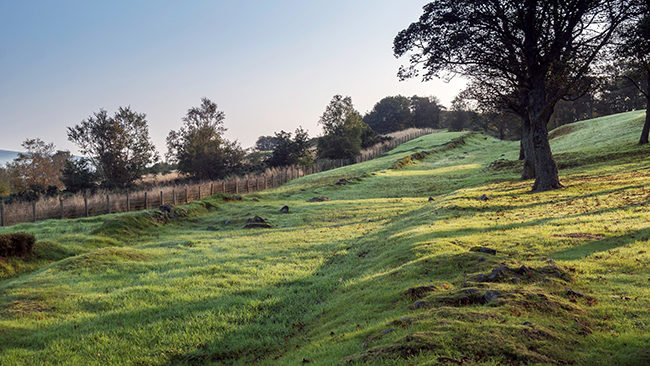
How the Romans tried to keep the Scots out
People have been building boundary walls to keep their enemies out for millennia.
In the 3rd century BC work began on the Great Wall of China as a defence from the Mongols.
Famous modern day examples include the Berlin Wall, dividing the communist east from our allies in West Germany, and the current West Bank wall dividing Israel and Palestine. Donald Trump’s promise of a wall to keep Mexicans out of the USA may still happen.
We have been building walls around our cities for even longer – think of Old Testament Babylon and Jericho.
The Roman Empire ruled Britain for over 400 years. We have much to thank them for – roads, plumbing, language, philosophy, religion and our modern Gregorian calendar to name but a few. They shaped our culture and society and even after invasions by the Jutes, Angles, Saxons, Celts, Vikings, Normans and the shift to Christianity we still owe much of our national identity to Roman influence.
The Roman Empire reached its pinnacle around 117 AD at over five million square kilometres, stretching as far as the Persian Gulf in the east, reaching to Sudan in the south and Scotland in the north west.
On his deathbed the Emperor Trajan, a strong soldier-emperor, appointed his cousin Hadrian Aelius as his successor. When Hadrian’s parents died young, Trajan and the Empress Pompeia Plotina adopted the young boy and his sister, and with no children of their own Hadrian was the obvious choice for accession to the throne.
In 1503 Renaissance philosopher Niccolò Machiavelli named both Trajan and Hadrian as two of the ‘five good Emperors’. Their reigns were successful and prosperous and the Roman Empire was at its greatest during their time.
After inheriting this vast empire in 177 AD, Hadrian immediately set about securing his boundaries. Problems in the east after Trajan’s Parthian campaign to conquer Mesopotamia (in modern-day Iraq) resulted in several revolts across eastern and southern Roman frontiers, and Hadrian spent the first few years of his rule securing these borders.
In 84 AD the Celtic Caledonian tribes, led by a fearsome chief called Calgacus, fought the Imperial Roman Army in the Mons Graupius (Grampian Mountains). The Romans were victorious in battle, but the Caledonians reverted to guerrilla tactics, continuing to raid and pillage their camps, proving to be an expensive nuisance and ultimately winning the war.
With wars in the east costing the Roman Empire dearly, Caledonia was largely abandoned.
In 118 AD Hadrian ordered his armies to define the north western edges of the Roman Empire with a great wall, and in 122 AD Hadrian came to Britannia to review their progress on the Vallum Aelium, the frontier of Aelius. It is likely that Hadrian was inspired by The Great Wall of Gorgon, built in 1750 BCE in Hyrcania (modern day Iran), by defensive city walls such as the Servian Wall constructed around Rome, and by the walls built around Chester and York by Emperors Vespasian and Titus in 70-80 AD.
The finished wall cut off the barbaric northern tribes from the Roman-ruled south, starting at the mouth of the River Tyne and stretching across the width of North England to the Firth of Solway.
This 73-mile stretch is believed to have taken three legions six years to complete and remained an active military line for some 300 years. Stone milecastles marked every Roman mile (1,000 paces), and between each milecastle two watch towers topped the 6ft thick wall. After his visit Hadrian ordered extra forts at seven-mile intervals and, in places where the land was flat, a six-metre deep ditch, flanked by mounds either side, called a vallum.
Later the Romans tried again, advancing into Scotland and erecting the Antonine Wall from the Firth of Forth to the Firth of Clyde. It was smaller and mainly constructed from turf and timber, with a large trench on the northern side and pointed stakes to deter any unruly Highlanders from crossing.

The Antonine Wall ditch on Bar Hill above Twechar, East Dunbartonshire
Deter it did not. After continuous breaches by local tribes, the wall was quickly abandoned and the Romans retreated to Hadrian’s far more robust wall.
Recent archaeological research has found that the Romans held over 260 military camps north of the wall – many more than any other part of Europe.
Yet, they still couldn’t subdue the fierce and persistent Caledonian tribes. Outlines of the Pennymuir Roman camps in the Borders survive to this day, and a recently excavated camp in Kintore, Aberdeenshire, has exposed evidence of a temporary Roman military settlement the size of six football pitches.
So why was Caledonia so difficult to secure under Roman rule? Today we are presented with an image of uncivilised, fearless and barbaric bands of Celtic warriors fighting naked with crude spears and axes, whose surprise guerilla tactics wreaked havoc and showed no mercy.
To the highly disciplined Roman legions these raids were an unpredictable and costly irritant. Besides, the economic benefit of ruling Caledonia was not great, and a combination of these factors meant that it simply wasn’t worth it.
Long after the Romans’ retreat to defend Rome in the 5th century AD Hadrian’s Wall continued to mark the border between Britannia and Caledonia.
Not until the 1237 Treaty of York legally established the modern day border further north, was Northumberland returned to England.
TAGS

